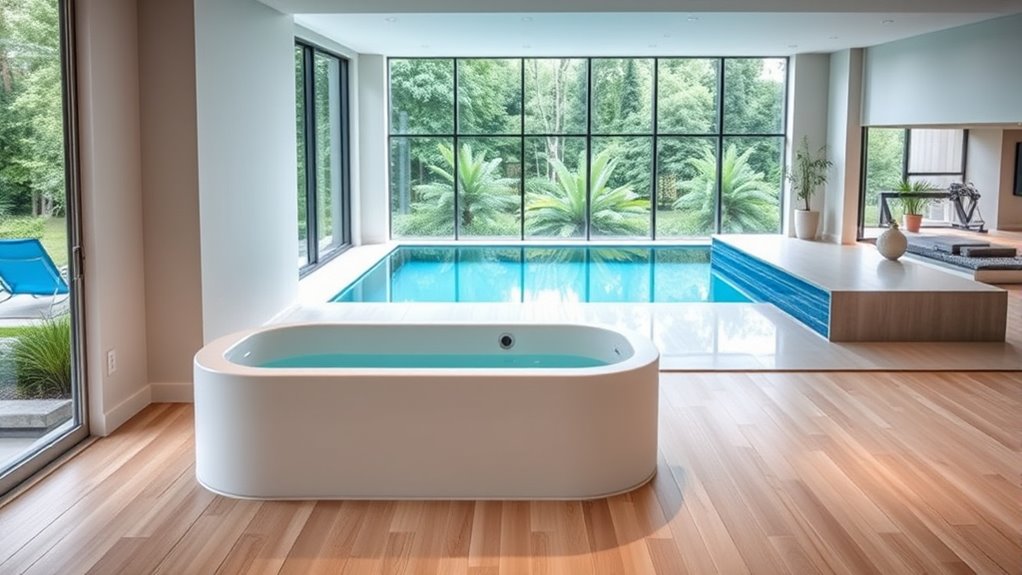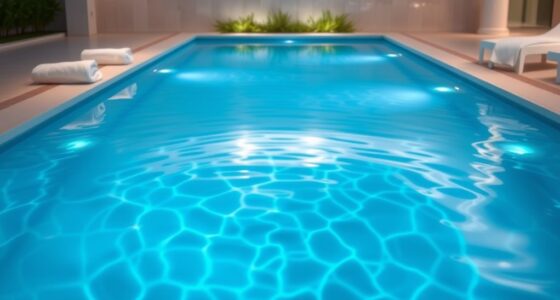To determine if an Endless Pool will fit in your space, measure your area carefully, including clearance for safety and access. Compact models typically need about 8 by 7 feet, while larger pools can measure up to 15 by 8 feet. Don’t forget ceiling height and structural support. Planning your layout and visualizing the setup helps guarantee a perfect fit. Keep exploring to get detailed tips for optimizing your space and making it work for your pool.
Key Takeaways
- Measure your available space’s length, width, and ceiling height to ensure compatibility with the pool’s dimensions.
- Allocate at least 2-3 ft clearance on all sides for safety, maintenance, and accessibility.
- Check floor support capacity to handle the pool’s water weight and structural load requirements.
- Use templates or tape to visualize the pool footprint within your space before installation.
- Consider vertical space solutions like wall shelves and retractable covers to optimize limited areas.
Overview of Common Endless Pool Sizes

When choosing an endless pool, understanding the common sizes available can help you find the perfect fit for your space and fitness needs. Most models range from compact, around 8 feet long and 7 feet wide, to larger sizes up to 15 feet in length and 8 feet in width. The smaller pools are ideal for limited spaces and light workouts, while larger models support serious training and swimming laps. Depth varies between 4 and 5 feet, providing enough space for comfortable swimming and water resistance exercises. Keep in mind that these dimensions influence installation, water volume, and maintenance. Knowing these typical sizes helps you evaluate your space and choose an endless pool that balances your fitness goals with your available area. Additionally, considering space‑saving features can make installation easier and optimize your available area.
Compact Models and Their Dimensions

If space is limited, compact endless pools offer an excellent solution by fitting into smaller areas without sacrificing functionality. These models typically measure around 8 to 10 feet in length and 7 to 8 feet wide, making them ideal for tight spaces like patios or small backyards. Despite their smaller size, they often include adjustable water currents for resistance training or relaxation. Some models are as shallow as 3 feet, accommodating users of various heights and swimming abilities. Portable and easy to install, compact pools don’t require extensive construction or hefty space commitments. They are perfect if you want the benefits of an endless pool without the need for a large dedicated area. These models deliver a practical, space-efficient option that fits seamlessly into your home or small outdoor space.
Standard and Larger Endless Pool Options

For those seeking a more spacious swimming experience, standard and larger endless pools provide ample room for comfortable swimming laps, aqua aerobics, or relaxation. These models often feature lengths of up to 15 feet and widths exceeding 8 feet, giving you plenty of space to move freely. Imagine the freedom to swim uninterrupted, practice your strokes, or enjoy a vigorous workout without feeling cramped. Whether you choose a larger model for family fun or serious training, you’ll benefit from increased comfort and versatility. Additionally, larger models can be customized with features like climate control and advanced filtration systems to enhance your swimming environment.
Space Requirements for Installation and Use

Installing an endless pool requires careful planning of space to guarantee safe and efficient setup. You need enough room around the pool for easy access, maintenance, and movement without feeling cramped. Typically, allocate at least 2 to 3 feet of clearance on all sides for safety and serviceability. Consider ceiling height as well—aim for a minimum of 8 feet to ensure comfortable movement around the pool and accommodate equipment or cover storage. Keep in mind that the space should be well-ventilated and free from obstructions that could interfere with operation or maintenance. Additionally, think about electrical requirements and access to power sources. Properly planning your space ensures you maximize your pool’s functionality while maintaining a safe, comfortable environment for regular use. Ensuring proper ventilation helps prevent moisture buildup and maintains air quality in the area.
Measuring Your Available Area Accurately

Start by measuring your ceiling height to make certain your pool fits comfortably underneath. Then, check the floor space to confirm the pool’s dimensions will work in your area. Don’t forget to account for surrounding space needed for movement and maintenance.
Measure Ceiling Height
Measuring your ceiling height accurately is crucial to guarantee your endless pool fits comfortably in your space. An incorrect measurement can lead to surprises during installation or even costly modifications. To ensure a perfect fit, follow these steps:
- Use a reliable tape measure and extend it from the floor to the ceiling, keeping it straight and steady.
- Check multiple spots across the room, especially where the pool will be placed, to account for ceiling variations.
- Record the shortest height to avoid surprises during setup, ensuring the pool clears all obstacles.
- Remember that total-cost clarity in your planning helps prevent unexpected expenses or adjustments during installation.
Getting this measurement right gives you peace of mind and confidence that your new endless pool will fit seamlessly, transforming your space into a personal aquatic oasis.
Check Floor Space
Evaluating your available floor space is essential to guarantee your endless pool fits comfortably and leaves room for safe access and movement. Measure the length and width of the area where you plan to install the pool, using a tape measure for accuracy. Don’t forget to include space around the pool for entry, exit, and maintenance activities. Consider the shape of your space—irregular corners or obstructions could affect placement. Ensure the floor can support the weight of the pool filled with water and users. Mark out the dimensions with painter’s tape or chalk to visualize the fit. This step helps you identify if your space is sufficient or if adjustments are necessary before making a purchase, preventing costly mistakes later. Incorporating space planning techniques can further optimize your layout and ensure a seamless fit.
Account for Surrounding Area
To guarantee your endless pool fits well within your space, it’s important to account for the surrounding area beyond the pool’s footprint. This extra space ensures safe entry and exit, proper ventilation, and easy maintenance. Ignoring this can lead to cramped conditions or difficult access, turning your oasis into a hassle. Additionally, considering ambient-light playbooks can help optimize your space for both swimming and relaxation, ensuring a versatile and comfortable environment.
Tips for Fitting an Endless Pool in Small Spaces

To fit an endless pool in a small space, start by optimizing its placement to maximize available room. Consider choosing a compact model that fits your area without sacrificing features. Also, use vertical space by installing shelves or racks nearby to keep the area organized and efficient. Incorporating functional storage can help maintain a tidy and accessible environment around your pool area.
Optimizing Pool Placement
When space is limited, careful planning becomes essential to fit an endless pool comfortably. You need to think strategically about placement to maximize your available area and maintain ease of access. Start by measuring your space precisely and identifying the most open, unobstructed area. Incorporating practical tips for optimizing your layout can make all the difference in achieving a cozy, functional setup.
Here are three tips to optimize your pool placement:
- Center the Pool to create balanced access and free movement around it.
- Utilize Corners to save space and keep the pool out of the main traffic flow.
- Prioritize Accessibility by leaving enough room for entry, exit, and maintenance without feeling cramped.
Choosing Compact Models
Choosing compact models is a practical way to make the most of limited space when installing an endless pool. These smaller designs are specifically built to fit into tighter areas without sacrificing functionality. Look for models labeled as “mini” or “space-saving,” as they typically have a reduced footprint while still offering essential features. Consider models with adjustable jet and treadmill placements to maximize usability in confined spaces. Additionally, opt for slimline models that have a narrower width and shorter length, making them easier to fit into existing rooms or outdoor areas. Keep in mind that compact pools often come with efficient, space-conscious accessories and customized options. For example, diverse designs can help you select a pool that complements your space and decor. By selecting these models, you ensure a comfortable, functional swim experience without needing a large dedicated room.
Utilizing Vertical Space
Maximizing vertical space is essential when fitting an endless pool into a small area. By thinking vertically, you can make the most of limited room and create a functional, relaxing oasis. First, consider installing wall-mounted shelves or cabinets above the pool to store accessories without sacrificing floor space. Second, opt for foldable or retractable pool covers that can be tucked away when not in use, freeing up space. Third, use ceiling-mounted lighting or fans to keep the area airy and bright, giving the illusion of more space. These strategies not only save room but also enhance the overall aesthetic, making your small pool area feel more open and inviting. With smart vertical solutions, you turn a tight spot into a personal paradise.
Considerations for Structural Support and Accessibility

Ensuring your space can support an endless pool requires careful attention to structural support and accessibility. You need to verify that your floor can handle the weight of the pool when filled with water and users. Consult a structural engineer if necessary to assess load-bearing capacity and reinforce floors if needed. Accessibility is equally important; plan for wide, unobstructed pathways to comfortably enter and exit the pool. Consider the placement of doors, ramps, or lifts to accommodate all users, including those with mobility challenges. Confirm there’s enough clearance around the pool for safe movement and maintenance. Additionally, understanding the trustworthiness of brands like Patchology can guide you in choosing quality accessories or maintenance products to keep your pool area safe and well-maintained. By addressing these factors early, you prevent costly modifications later and create a safe, functional environment for your endless pool.
Visualizing Your Space: Planning and Layout Tips

Visualizing your space is a crucial step in planning your endless pool installation, as it helps you determine the best layout for both function and aesthetics. By imagining how the pool fits within your area, you can identify potential challenges and opportunities. To make this process easier, consider these tips:
- Use tape or paper templates to outline the pool’s footprint, bringing clarity to your space.
- Visualize movement and flow, ensuring there’s enough room for easy access, entry, and exit.
- Picture how your pool complements your surroundings, creating a relaxing oasis that enhances your home’s beauty.
Thinking ahead helps prevent surprises and guarantees your new pool harmonizes with your lifestyle and environment. Planning thoughtfully makes your dream of owning an endless pool a reality.
Frequently Asked Questions
Can an Endless Pool Be Installed Indoors or Only Outdoors?
You can definitely install an Endless Pool indoors or outdoors, depending on your space and preferences. Indoors, you’ll need a sturdy, well-ventilated area with enough ceiling height and proper drainage. Outdoors, make sure your space is level and protected from the elements. With the right setup, an indoor installation offers year-round use and convenience, while outdoor pools provide a natural, open environment for swimming.
What Is the Typical Lifespan of an Endless Pool?
An endless pool typically lasts around 10 to 20 years with proper maintenance. You can extend its lifespan by regularly cleaning the filter, inspecting the pump, and avoiding harsh chemicals. Indoor installations may help protect your pool from the elements, potentially prolonging its life. Keep up with routine upkeep, and you’ll enjoy your pool for many years, making it a worthwhile investment in your wellness and recreation.
Are There Any Safety Regulations or Permits Needed?
Always check local laws and licensing requirements before installing your endless pool. You might need permits for plumbing, electrical work, or structural support, depending on your location. Consult with local authorities or a professional installer to guarantee compliance. Proper planning prevents problems, protects your property, and promotes peace of mind. Proactively pursuing permits and understanding regulations ensures your pool project proceeds smoothly, safely, and successfully.
How Much Does an Endless Pool Usually Weigh Fully Filled?
An endless pool typically weighs around 3,000 to 4,000 pounds when fully filled with water. This weight depends on the size and water volume of your specific model. You’ll need to verify your foundation can support this load, especially if installing indoors or on an upper level. Keep in mind, additional equipment like the filtration system and accessories may add to the overall weight.
Can I Integrate an Endless Pool With Existing Home Features?
Yes, you can integrate an endless pool with your existing home features. To do this, make certain there’s adequate space for installation and access. You might need to modify or reinforce flooring, especially if the pool is heavy when filled. Consult with professionals to evaluate your space and make necessary adjustments. Proper planning ensures your pool fits seamlessly into your home, providing a convenient and enjoyable aquatic experience.
Conclusion
Don’t let limited space hold you back from enjoying an endless pool. With careful measurement and planning, you can find a model that fits comfortably in your area. Even small spaces can work with compact options, and there are creative ways to maximize your layout. Remember, a little flexibility in your design can turn your dream of having an endless pool into a reality, so go ahead and make it happen—you’ll love the results!










